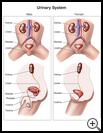
Painful Bladder Syndrome
________________________________________________________________________
KEY POINTS
- Painful bladder syndrome (PBS) is a condition where you have pain in your bladder, belly, lower back, or genitals that has lasted for more than 6 weeks.
- Treatment may include bladder filling or stretching, medicines, and lifestyle changes.
- Ask your healthcare provider how to take care of yourself at home including what symptoms or problems you should watch for and what to do if you have them.
________________________________________________________________________
What is painful bladder syndrome?
Painful bladder syndrome (PBS) is a condition where you have pain in your bladder, belly, lower back, or genitals that has lasted for more than 6 weeks. Usually you do not have kidney stones or an infection. In can happen in both men and women, though women have it more often than men. It is also called bladder pain syndrome or interstitial cystitis.
The bladder is part of your urinary tract, which includes your:
- Kidneys, which make urine
- Ureters, which are the tubes that carry urine from the kidneys to the bladder
- Bladder, which stores urine
- Urethra, which is the tube that drains urine from the bladder and out of the body
What is the cause?
The exact cause of PBS is not known. It may be a problem with your immune system. The immune system is your body’s defense against infection. Some people with PBS have abnormal changes in the lining of the bladder. PBS is not cancer and does not cause cancer.
What are the symptoms?
The symptoms range from mild to severe, even in the same person, and symptoms may come and go. They may include:
- Urinating more often
- Urinating in small amounts
- Feeling an urgent need to urinate or feeling that your bladder is always full
- Pain or burning when you urinate
- Pain in your bladder, belly, lower back, or genitals
- Pain after sitting for a long time
- For women, pain during your menstrual period
- For women, pain during vaginal sex
- For men, pain in the scrotum or penis
How is it diagnosed?
Your healthcare provider will ask about your symptoms and medical history and examine you. Tests may include:
- Blood tests
- Urine tests
- Cystoscopy, which uses a slim, flexible, lighted tube to look inside your bladder. A biopsy may be done during a cystoscopy to take a small sample of tissue for testing.
- Urodynamic testing, in which your healthcare provider measures the size of your bladder during a cystoscopy by filling your bladder with fluid (bladder stretching). You will be given medicine so you don’t feel pain.
If you are a female, your healthcare provider will also check your ovaries, fallopian tubes, uterus, vagina, and cervix, which are parts of your reproductive system.
If you are a male, your healthcare provider will also check your prostate.
How is it treated?
There is no known cure for PBS, but treatment may help with the symptoms.
Possible treatments include:
- Bladder filling or stretching, which your healthcare provider may use to diagnose PBS, but that also may give you pain relief after the test
- Medicine put into the bladder or taken by mouth that may help repair the bladder lining
- Medicine for pain, anxiety, or depression
- Diet changes that include limiting alcohol, tomatoes, spicy foods, chocolate, drinks with caffeine, citrus foods, and artificial sweeteners that may irritate the bladder
- Quitting smoking
- Exercise as recommended by your healthcare provider, including stretching exercises to reduce muscle tightness
- Electrical nerve stimulation
- Bladder training, which teaches you to empty your bladder on a schedule rather than waiting until you feel the urge. For example, you might go to the toilet 20 to 30 minutes after each meal, at least twice between meals, and before you go to bed. You can adjust the schedule as you learn the frequency that works best. You can even set a timer to remind you when bathroom visits are due.
- Physical therapy to strengthen pelvic floor muscles
- Surgery in rare cases
How can I take care of myself?
Follow the full course of treatment prescribed by your healthcare provider. In addition:
- Keep track of your symptoms in a diary or on the calendar. Let your provider know what seems to help make your symptoms worse.
- Use a heating pad set on low, or a covered hot water bottle, on your lower belly.
- Soak in a tub of warm (not hot) water.
- Don’t wear tight underwear or clothing that puts pressure on your belly.
- Eat high-fiber foods to help you have a bowel movement without straining.
- Take care of your health. Try to get at least 7 to 9 hours of sleep each night. If you smoke, try to quit. If you want to drink alcohol, ask your healthcare provider how much is safe for you to drink. Learn ways to manage stress. Exercise according to your healthcare provider's instructions.
- You may want to try massage by a trained massage therapist, or acupuncture, which uses special needles to stimulate the release of your body's natural painkillers.
- Find a support group to help you understand that you are not alone. Support groups also provide a safe place to share feelings.
Ask your provider:
- How and when you will get your test results
- How long it will take to recover
- If there are activities you should avoid and when you can return to your normal activities
- How to take care of yourself at home
- What symptoms or problems you should watch for and what to do if you have them
Make sure you know when you should come back for a checkup. Keep all appointments for provider visits or tests.
For more information:
- Interstitial Support Association
http://www.ichelp.org/support/

